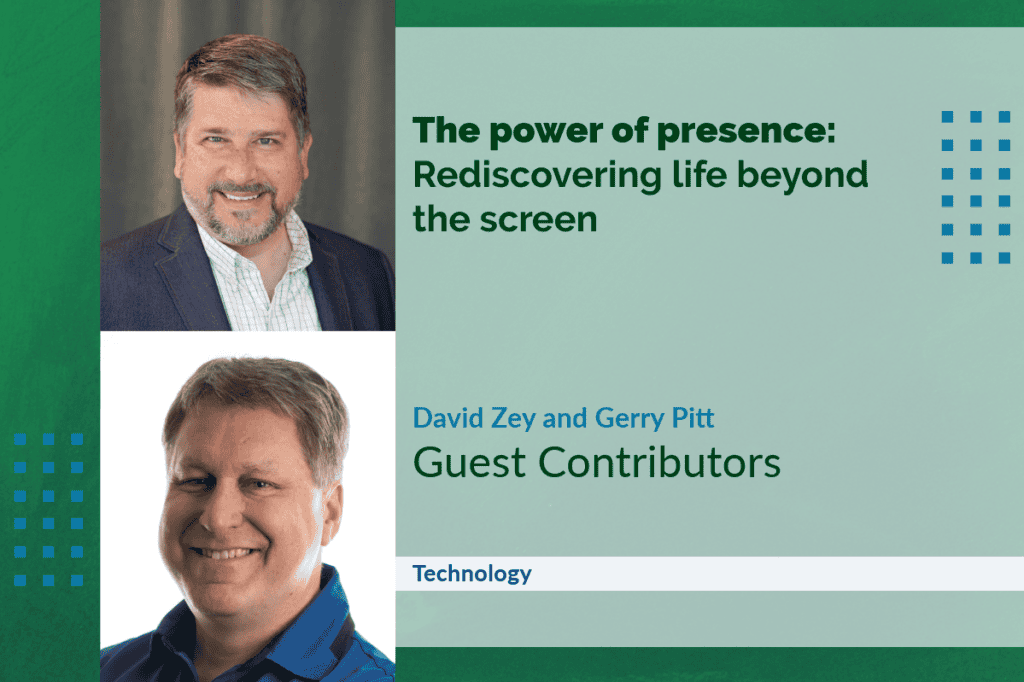
May 19, 2025
Imagine a space where smartphones are nowhere to be found.
No selfies, no status updates, no checking notifications every few minutes.
Just people, fully present, engaging with the world and one another.
Such a space still exists at Augusta National Golf Club during the Masters Tournament.
In a culture defined by constant digital connection and our need to be online, the Masters offers a rare exception: no phones allowed.
For visitors, the absence of devices creates a striking contrast to daily life.
With phones set aside, attention shifts toward the course, the people around them and the moment itself.
This isn’t a nostalgic yearning for the past.
It’s a conscious decision to value presence over distraction.
What unfolds is something simple: genuine awareness.
The silence where notification pings once reigned becomes a space to observe, listen and feel the weight of unfiltered experiences.
People notice the color of the grass, the movement of the wind and the expression on a stranger’s face.
The usual digital wall between experience and reflection falls away.
This atmosphere extends beyond the attendees.
The players engage with an attentive audience, unaffected by lenses and screens.
There’s an intimacy created by shared focus.
No one is documenting the moment for later – they’re living it now.
Crafting a balanced digital life
Consider the way many people adopt technology today.
New gadgets and apps are often embraced without pause or purpose, added into your life before considering the consequences.
Technology delivers answers without effort, turning meaningful pursuits into clicks.
The journey is no longer the reward because it has been bypassed.
Over time, what seemed like minor conveniences subtly reshaped daily patterns, family dynamics and even personal identity.
The Amish offer a model that turns this approach on its head.
Rather than shunning modern technology altogether, they practice a high degree of intentionality.
Each community makes careful, collective decisions about whether and how to use specific technologies based on whether they serve or disrupt their way of life.
It’s not the presence of technology itself that they resist, but it’s the lack of limits.
Their aim is to protect things like family cohesion, community interaction and self-reliance.
When a device or service threatens these values, they create boundaries to prevent intrusion.
Electricity comes from independent sources, phones are shared and placed outside the home and entertainment tech is either stripped down or excluded entirely.
This thoughtful evaluation process isn’t about fear or stubbornness – it’s about clarity.
The Amish know what they stand for.
They know the individual never truly stands apart from the community.
Each person is an expression of the community it is sustained by.
Every technological decision is made in the light of their values, not in the shadow of marketing trends for profit.
They understand that tools should enhance life, not direct it.
Weekly rhythm: Choosing rest over routine
If the Masters shows what’s possible in a curated, communal setting, and the Amish show what’s possible with a cultural framework, then the concept of a weekly Technology Sabbath offers something anyone can try: a reset.
The idea is rooted in the simple act of stepping away, just for one day each week, from the screens, pings and digital obligations that fill our lives.
This isn’t about prioritizing moral values or denying yourself a luxury.
It’s about space.
Creating space for thought, reflection, connection and rest.
Many who try a Tech Sabbath report rediscovering pleasures that had slowly disappeared: reading a physical book without distraction, taking a long walk without headphones, enjoying a meal without reaching for a phone between bites.
Our lives, like the universe, are mostly made of space, which are the quiet moments between defining events.
But technology often rushes in to fill that space, robbing us of the stillness where meaning is made.
The act of unplugging reveals just how much of our time is normally filled with digital noise.
Unplugging doesn’t come easily.
At first, the urge to check a device can feel nearly instinctual.
Habits formed over years don’t dissolve in a single afternoon.
But that discomfort also reveals just how entrenched the digital reflex has become and how worthwhile it is to challenge it.
What makes the Tech Sabbath so powerful isn’t just the absence of technology, but the presence of other things.
Time becomes something to savor.
Stillness reemerges.
Even boredom, once banished by endless scrolling, becomes a doorway to creativity and peace.
Mindfulness naturally follows when we create these intentional gaps in our digital routine.
With fewer distractions, our awareness shifts inward and outward simultaneously, and we notice how we’re feeling, what we’re thinking and what surrounds us.
This heightened state of presence fosters clarity and calm.
Instead of reacting to the latest notification, we begin responding to life with purpose.
Whether it’s noticing the sound of the wind through trees, the warmth of a cup of coffee or the tone in a loved one’s voice, mindfulness restores the richness in small moments.
It reconnects us with the real world, which, unlike the digital one, doesn’t demand attention but quietly rewards it.
The digital world, on the other hand, would not exist without our attention because its very survival is predicated on gaining and using our attention.
A recalibrated life
So, what would it mean to embrace this mindset more broadly?
Start by rethinking your relationship with your devices, not just functionally, but philosophically.
What role do they play in your life?
What values do they support?
Which ones do they erode?
Instead of adopting every new technology by default, consider adopting the Amish process of discernment.
Reflect on how a tool might affect your family, your mental health, your spiritual life or your ability to be fully present.
Ask not just “what does this do?”
But “what does this do to me?”
Implementing this mindset doesn’t require drastic changes.
Small, consistent shifts often make the biggest difference.
Setting hours where the phone is off limits, removing certain apps or having communal rules about screen use can all help create a healthier balance.
Families might find it helpful to agree on shared guidelines like no screens at meals or screen-free Sundays.
These aren’t rules for the sake of rules, they’re opportunities to build rituals that restore connection and reflection.
Presence as practice
Choosing to be present, truly present, is a countercultural act.
It requires saying no to the siren call of instant updates and infinite feeds.
But in doing so, we open ourselves to richer, more grounded experiences.
At the Masters, people leave not just with souvenirs but with a renewed sense of aliveness.
In Amish communities, intentional boundaries around technology preserve depth in human relationships.
And in homes that adopt a weekly Tech Sabbath, peace often returns to the pace of daily life.
What these examples share is a commitment to living on purpose, not just letting the stream of information carry them along, but navigating with intention.
The rewards are not abstract.
They’re felt in conversations that go deeper, in meals that are more joyful, in minds that have space to wander.
Presence doesn’t just happen – it’s something we must make room for.
Another valuable dimension in reclaiming presence is the intentional shift from the fear of missing out (FOMO) to the joy of missing out (JOMO).
Rather than anxiously monitoring what might be happening elsewhere, JOMO invites us to embrace the richness of what is already around us.
This shift is grounded in simple yet profound practices: prioritizing quality sleep, nurturing personal connections through conversation or handwritten notes, reflecting with gratitude, writing by hand to enhance mindfulness and finding contentment in the familiar
rhythms of daily life.
These basics reconnect us to ourselves and help us recognize that peace isn’t found in constant stimulation, but in choosing what matters and letting go of what doesn’t.
The hidden gift of less
Tech tools are here to serve us, not the other way around.
And yet, when we never pause to examine their role, we risk being shaped by them in ways that erode the very things we hold dear, such as relationships, creativity, rest and a sense of meaning.
By embracing intentionality, whether through a phone-free experience like the Masters, the value-driven discernment of Amish communities or a personal ritual like the Tech Sabbath, provides an opportunity to reconnect with what matters most.
Instead of being pulled along by every digital distraction, we begin to direct our focus with purpose, choosing what deserves our time and attention.
This shift does not require abandoning the digital world.
It asks only that we approach it thoughtfully, with a sense of purpose.
When we start asking better questions – “What does this add to my life?”, “What does it replace?”, “Does this tool serve my values or distract me from them?” – we begin to see the outlines of a more deliberate, grounded life.
The absence of screens is not a void – it is an invitation to experience time more slowly.
To savor moments more deeply.
To listen more fully.
To reconnect with nature, with people and with ourselves.
Presence is a gift we give ourselves.
It costs nothing but attention, and yet it yields everything from clarity and joy to connection and renewal, leading to a richer life.
We might not like what we see if we slow down, but reclaiming our life may mean confronting those things we have been escaping through our tech.
In reclaiming presence, we reclaim our lives not just from distraction, but for a deeper sense of fulfillment and purpose.
So, start small.
Make space.
Pay attention.
Be present.
You may discover that in doing less digitally, you’re living more fully.
 KRB’s bringing the BBQ back to basics
KRB’s bringing the BBQ back to basics Powering forward with solar energy
Powering forward with solar energy







